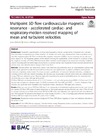Multipoint 5D flow cardiovascular magnetic resonance - accelerated cardiac- and respiratory-motion resolved mapping of mean and turbulent velocities
dc.contributor.author
Walheim, Jonas
dc.contributor.author
Dillinger, Hannes
dc.contributor.author
Kozerke, Sebastian
dc.date.accessioned
2019-08-07T09:12:24Z
dc.date.available
2019-08-03T02:30:07Z
dc.date.available
2019-08-07T09:12:24Z
dc.date.issued
2019-07-22
dc.identifier.issn
1097-6647
dc.identifier.issn
1532-429X
dc.identifier.other
10.1186/s12968-019-0549-0
en_US
dc.identifier.uri
http://hdl.handle.net/20.500.11850/356387
dc.identifier.doi
10.3929/ethz-b-000356387
dc.description.abstract
Background
Volumetric quantification of mean and fluctuating velocity components of transient and turbulent flows promises a comprehensive characterization of valvular and aortic flow characteristics. Data acquisition using standard navigator-gated 4D Flow cardiovascular magnetic resonance (CMR) is time-consuming and actual scan times depend on the breathing pattern of the subject, limiting the applicability of the method in a clinical setting.
We sought to develop a 5D Flow CMR framework which combines undersampled data acquisition including multipoint velocity encoding with low-rank image reconstruction to provide cardiac- and respiratory-motion resolved assessment of velocity maps and turbulent kinetic energy in fixed scan times.
Methods
Data acquisition and data-driven motion state detection was performed using an undersampled Cartesian tiny Golden angle approach. Locally low-rank (LLR) reconstruction was implemented to exploit correlations among heart phases and respiratory motion states. To ensure accurate quantification of mean and turbulent velocities, a multipoint encoding scheme with two velocity encodings per direction was incorporated. Velocity-vector fields and turbulent kinetic energy (TKE) were obtained using a Bayesian approach maximizing the posterior probability given the measured data. The scan time of 5D Flow CMR was set to 4 min.
5D Flow CMR with acceleration factors of 19 .0 ± 0.21 (mean ± std) and velocity encodings (VENC) of 0.5 m/s and 1.5 m/s per axis was compared to navigator-gated 2x SENSE accelerated 4D Flow CMR with VENC = 1.5 m/s in 9 subjects. Peak velocities and peak flow were compared and magnitude images, velocity and TKE maps were assessed.
Results
While net scan time of 5D Flow CMR was 4 min independent of individual breathing patterns, the scan times of the standard 4D Flow CMR protocol varied depending on the actual navigator gating efficiency and were 17.8 ± 3.9 min on average. Velocity vector fields derived from 5D Flow CMR in the end-expiratory state agreed well with data obtained from the navigated 4D protocol (normalized root-mean-square error 8.9 ± 2.1%). On average, peak velocities assessed with 5D Flow CMR were higher than for the 4D protocol (3.1 ± 4.4%).
Conclusions
Respiratory-motion resolved multipoint 5D Flow CMR allows mapping of mean and turbulent velocities in the aorta in 4 min.
en_US
dc.format
application/pdf
en_US
dc.language.iso
en
en_US
dc.publisher
BioMed Central
en_US
dc.rights.uri
http://creativecommons.org/licenses/by/4.0/
dc.subject
4D flow MRI
en_US
dc.subject
Velocity mapping
en_US
dc.subject
Turbulent kinetic energy
en_US
dc.subject
Respiratory motion compensation
en_US
dc.subject
Cartesian Golden angle
en_US
dc.subject
Low-rank image reconstruction
en_US
dc.subject
Cardiovascular magnetic resonance
en_US
dc.title
Multipoint 5D flow cardiovascular magnetic resonance - accelerated cardiac- and respiratory-motion resolved mapping of mean and turbulent velocities
en_US
dc.type
Journal Article
dc.rights.license
Creative Commons Attribution 4.0 International
ethz.journal.title
Journal of Cardiovascular Magnetic Resonance
ethz.journal.volume
21
en_US
ethz.journal.issue
1
en_US
ethz.journal.abbreviated
J Cardiovasc Magn Reson
ethz.pages.start
42
en_US
ethz.size
13 p.
en_US
ethz.version.deposit
publishedVersion
en_US
ethz.grant
Interlacing Magnetic Resonance Velocity Encoding and Computational Fluid Dynamics for Mapping Wall Shear Stress in the Cardiovascular System
en_US
ethz.identifier.wos
ethz.identifier.scopus
ethz.publication.place
London
en_US
ethz.publication.status
published
en_US
ethz.leitzahl
ETH Zürich::00002 - ETH Zürich::00012 - Lehre und Forschung::00007 - Departemente::02140 - Dep. Inf.technologie und Elektrotechnik / Dep. of Inform.Technol. Electrical Eng.::02631 - Institut für Biomedizinische Technik / Institute for Biomedical Engineering::09548 - Kozerke, Sebastian / Kozerke, Sebastian
ethz.leitzahl.certified
ETH Zürich::00002 - ETH Zürich::00012 - Lehre und Forschung::00007 - Departemente::02140 - Dep. Inf.technologie und Elektrotechnik / Dep. of Inform.Technol. Electrical Eng.::02631 - Institut für Biomedizinische Technik / Institute for Biomedical Engineering::09548 - Kozerke, Sebastian / Kozerke, Sebastian
ethz.grant.agreementno
149567
ethz.grant.fundername
SNF
ethz.grant.funderDoi
10.13039/501100001711
ethz.grant.program
Projektförderung in Biologie und Medizin (Abteilung III)
ethz.date.deposited
2019-08-03T02:30:32Z
ethz.source
SCOPUS
ethz.eth
yes
en_US
ethz.availability
Open access
en_US
ethz.rosetta.installDate
2019-08-07T09:12:38Z
ethz.rosetta.lastUpdated
2021-02-15T05:29:56Z
ethz.rosetta.versionExported
true
ethz.COinS
ctx_ver=Z39.88-2004&rft_val_fmt=info:ofi/fmt:kev:mtx:journal&rft.atitle=Multipoint%205D%20flow%20cardiovascular%20magnetic%20resonance%20-%20accelerated%20cardiac-%20and%20respiratory-motion%20resolved%20mapping%20of%20mean%20and%20turbulent&rft.jtitle=Journal%20of%20Cardiovascular%20Magnetic%20Resonance&rft.date=2019-07-22&rft.volume=21&rft.issue=1&rft.spage=42&rft.issn=1097-6647&1532-429X&rft.au=Walheim,%20Jonas&Dillinger,%20Hannes&Kozerke,%20Sebastian&rft.genre=article&rft_id=info:doi/10.1186/s12968-019-0549-0&
Files in this item
Publication type
-
Journal Article [130586]

